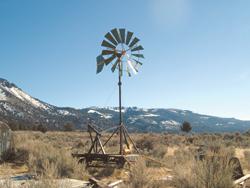
"It gets a lot of looks whenever I pull it down the highway," says Jack Vernon, Lakeview, Ore., about his home-built, 23-ft. high portable pneumatic windmill that folds down for transport on a 2-wheeled trailer, allowing Vernon to move the windmill at highway speeds between remote pastures.
"As far as I know, it's the only windmill on wheels. One person can set it up or take it down in only about 15 minutes," says Vernon, who built the windmill two years ago. He has about 400 cows and calves on his ranch with five wells scattered up to 20 miles apart. "I can set my windmill up and use it at one well until the pasture is grazed out, then take it down and move it to another pasture. It's a lot less expensive than buying three or four conventional windmills that I would probably use only 60 days a year.
"I built it mostly out of old components that I already had. A commercial portable 3-bladed windmill with comparable pumping capacity would sell for thousands of dollars and take a half day to set up or take down."
He started with an 8-ft. dia. fan off an old windmill and a 1-cyl. compressor that he already had. The fan, driveshaft, and compressor all mount on a steel plate that bolts onto one end of a floating axle off a 3/4-ton pickup. He cut the axle just behind the brake backing plate, and then stripped the hub, brakes and backing plate off. A short length of sq. tubing was welded to the shortened axle. It pins to the mast.
The fan mounts on a short shaft with pillow block bearings, and is bolted about 4 in. to the left of center as you look at it from the back. The fan chain-drives the compressor and is geared up via the combination of a 32-tooth sprocket to a 9-tooth sprocket on the compressor.
The air line runs down through the center of the axle to a 3-gal. air tank that mounts on the trailer's tongue. The air "brake" tank evens out surges in air pressure from the compressor caused by high, gusting winds. A 60 psi pop-off valve and a one-way back stop valve are used to regulate air pressure in the tank.
The windmill's folding tail is modeled after an auto furling design made popular by Hugh Piggott. It uses weight and gravity to turn the mill out of high winds, and is mounted 3 in. to the right of center.
The windmill's mast consists of a 12-ft. long hydraulic cylinder off an old Farm Hand F-10 front-end loader. It pins to the front of the trailer frame. He pulled the cylinder out 3 ft. and then welded it in place. A 1-ton hand-operated winch on front of the trailer is used to raise and lower the mast. Cable from the winch goes over a pulley on a gin pole at the front of the trailer. Metal guides extend from the gin pole to a "tower rest", and keep the mast stable when raising or lowering it in high winds.
Tie-down winches are welded to the back of the trailer, allowing support cables to the tower to be quickly tightened. Four 5-ft. long fold-up outrigger braces on the trailer can be lowered to the ground, keeping the windmill stable in high winds.
To set up the windmill, first he puts down the outriggers on the trailer. Then he uses the winch to crank up the tower and chain the mast to the gin pole. The support cables are then tightened. The last step is to plug the windmill's air hose to the well pump, and to hook a water hose up to the stock tank or storage tank.
"Both the air lines and water lines have quick couplers, so we only need a 7/16-in. wrench to tighten the U-bolts on the ground stabilizing arms. The rest is secured with pins," says Vernon.
He says he has one well where he has to use a positive displacement pump that produces only 3 gpm. "I can't use the Airlift technology on that well," he says.
He built his own diffusion pump out of a length of PVC pipe. The pipe has a series of holes drilled into it, with the air line going down and then coming up inside the water line for 3 ft., and from that comes back to the surface. He found the plans for the pump on a Canadian Pasture Management website.
"The pump can produce up to 17 gpm in a 25 mph wind. People who see it for the first time can't believe how much water it can pump," says Vernon.
"I plan to switch from the 1-cylinder compressor to a 2 or 3-cylinder model equipped with reed valves, which will increase the water rate at the calving ground. I'm also researching the idea of using solar panels to power a 12-volt air compressor. It will come in handy for those times when there isn't enough wind to operate the windmill," notes Vernon.
